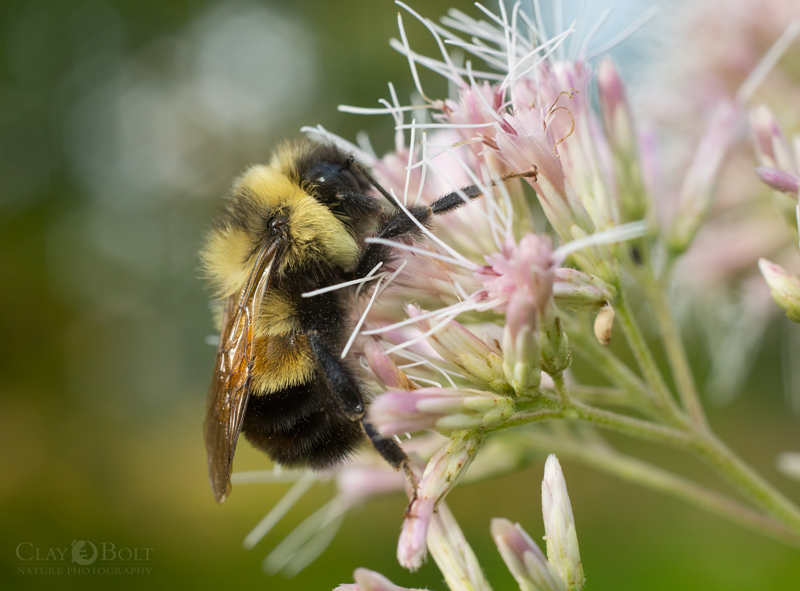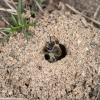In 2013 the Xerces Society petitioned the U.S. Fish and Wildlife Service to protect the rusty patched bumble bee (Bombus affinis) as an endangered species. Today the U.S. Fish and Wildlife Service announced that it is proposing to list the rusty patched bumble bee as an endangered species under the Endangered Species Act. This is a huge victory for bumble bee conservation.
The rusty patched bumble bee was once widespread, has precipitously declined from 9/10ths of its range, and has at least two threats for which existing regulatory mechanisms are inadequate to protect them, the widespread use of toxic insecticides whose toxicity to native bees were not adequately considered in the pesticide approval process and the distribution of commercial bumble bees within the range of the rusty patched bumble bee that are not required to be free of pathogens. Listing the rusty patched bumble bee under the ESA will require that its needs be considered when federal actions—like the registration of new pesticides—are taken. In addition, protecting this bee from threats of disease, pesticide, and habitat loss, may also help many of the other 3,600 species of native bees that exist on the American landscape.

This bumble bee has been the subject of much conservation attention over the last decade, and deservedly so. It has undergone a precipitous decline since the mid-1990s disappearing from nearly 90% of its historic range. Once common from Minnesota to Maine, and south through the Appalachians, this species has become increasingly rare, apparently persisting in only a few strongholds in the Upper Midwest, though a sighting of a single individual in Virginia in 2014 has given us all reason to remain hopeful that this species persists below the radar.
The Xerces Society has been actively working on the conservation of the rusty patched bumble bee since 2007. Our efforts began with a status review of this and two other imperiled bumble bee species, the yellow banded bumble bee (Bombus terricola) and the western bumble bee (Bombus occidentalis). That status review documents the significant declines that these species had experienced and outlined a list of potential threats including pathogens from commercial bumble bees, inadequacy of existing regulations to protect bumble bees, habitat fragmentation, and pesticide use as leading factors.
At that time we also launched our first bumble bee citizen science project. We developed wanted posters and pocket ID cards to educate the public, and asked people to send us observations of these rare species. The response was astounding. We received hundreds of emails with suspected observations of the rusty patched bumble bee. Significantly, these citizen scientists documented dozens of locations of this bumble bee in Minnesota, Wisconsin, Illinois, Ohio, and single observations in Pennsylvania, and Massachusetts. These citizen science records have been essential for understanding this animal’s current distribution, and has empowered the Xerces Society to initiate on-the-ground conservation measures, including the delivery of bumble bee specific habitat management guidelines to landowners and land managers in areas surrounding these important observations.

The success of this initial effort led us to form a partnership that resulted in the launch of Bumble Bee Watch in 2013. Bumble Bee Watch now has over 10,000 users, who have contributed more than 15,000 bumble bee observations throughout North America, including some important records of the rusty patched bumble bee. Unfortunately, the additional information we have gathered through Bumble Bee Watch confirms that the rusty patched bumble bee is currently largely limited to the upper Midwest in a small fragment of its former range.
Despite this nearly decade-long string of significant conservation efforts and accomplishments, the threats to the rusty patched bumble bee have not changed. Research supports the notion that pathogens harbored and distributed by commercial bumble bees have likely played a significant role in the declines observed in the rusty patched bumble bee. Nevertheless, the commercial bumble bee industry continues to grow and remains largely unregulated by the federal government. The only species widely available commercially, the common eastern bumble bee (Bombus impatiens), is being distributed throughout North America (including Mexico), well beyond its native range and with no requirement for independent disease testing. These commercial bumble bees, often arriving with high pathogen loads, are used in greenhouses and for open field pollination, routinely interacting and sharing pathologies with wild bumble bees, including, perhaps, the last remaining populations of the rusty patched bumble bee. There is also emerging evidence that the common eastern bumble bee is becoming established in the wild in southern British Columbia and Washington State.
In addition, pesticide use continues to increase throughout the range of the rusty patched bumble bee, including use of the highly toxic insecticides known as neonicotinoids. A number of scientific articles clearly document the lethal and sublethal effects that these chemicals are having on bees and other pollinators, and their use has intensified extensively within the rusty patched bumble bee’s range during the same time period that declines have been observed. Moreover, the massive increase in the past two decades in the use of the herbicide glyphosate on genetically modified corn and soybean fields has been effective at eliminating milkweed from the agricultural landscape. It is likely that other wildflowers have also been eliminated from farm edges – and it is reasonable to assume that a major loss of floral resources from the Upper Midwest could have had an effect on the rusty patched bumble bee. While no direct link has been made from the use of these pesticides to the declines observed in the rusty patched bumble bee there is little doubt that stressors like pesticides at the very least put increased pressures on an already imperiled bumble bee, especially when one considers the scope at which these chemicals are being adopted and used.
The lack of evidence of any significant recovery, coupled with the evidence of increasing risks to wild bumble bees led the Xerces Society to file a petition to list the rusty patched bumble bee as an endangered species under the Endangered Species Act (ESA) in 2013. In 2014, we partnered with the NRDC to encourage the USFWS to take action on our petition. The ESA is a powerful piece of legislation which provides important protections for imperiled animals. With ESA protection, remaining populations of this species will likely be protected from site specific threats and the bee’s habitat will likely benefit from critical habitat designations, as well as from species recovery plans. Government agencies will also need to address issues such as the registration and use of new pesticides that may be harmful to this species and the movement of commercial bumble bees which may transfer disease to wild bumble bees; issues that have not been thoroughly addressed by regulatory agencies to date due to a lack of political will.
Today’s news is excellent, but there are many other warranted species proposed for listing that do not receive this level of protection. For me this finding brings up a deeper issue surrounding my work as a conservation biologist. Is there value in one species over another, and how do we determine those priorities? This is a difficult question, and one for which I do not have an answer. In my ideal world we wouldn’t have these decisions to make, and the conservation of all species would receive equal treatment as the past, current, and future value of any individual species is immeasurable. But I recognize that resources are scarce in an increasingly fragmented world in which many species face extinction. I applaud the USFWS in making a decision that will make a difference for this species—and likely so many others by proxy. It is supported by clear and convincing evidence, and with coordinated efforts by government, industry, and the general public, the opportunity still exists for significant recovery for the rusty patched bumble bee.
In addition to this listing decision, I must remain hopeful that the tides of change will continue to favor the preservation of native bumble bees and pollinators. As we continue to recognize the crucial link that pollinators and other invertebrates have to our own survival, eyes are opening, and attitudes are changing. Much of what gives me hope is the response to our conservation efforts over the last several years. Recently we helped to produce a film about the rusty patched bumble bee which has been viewed thousands of times, and spurred over 128,000 people to sign a petition to encourage the USFWS to take action to protect this species. That kind of engagement gives me hope. In this case, that kind of engagement may have made a difference.
The more I interact with the public, the more I realize that so many people care about the plight of the rusty patched bumble bee and want to help, but for many the barrier is not knowing what to do. Our work at the Xerces Society is changing that. We’ve provided evidence-based guidance on how to protect, create and enhance habitat in a way that makes a difference. The federal protections that this listing will bring will help, but the creation of habitat will be essential to this species survival and hopeful recovery. By our choices and actions, we can continue to create positive change for all species
The methods are simple, and most anyone can help. The rusty patched bumble bee, and all native bees need three things, all of which you can help to provide in your backyard, in your communities, and beyond:
- Flowers upon which to forage from early spring through fall;
- a safe place to build their nest and overwinter; and
- a pesticide free environment, also protected from the pressures of introduced diseases from commercial bees.
In addition to the above, when you’re in your backyards, and in parks and natural areas, keep an eye out for these beautiful creatures. Submit your sightings to Bumble Bee Watch, and help us track the populations of this and other bumble bees. It is becoming increasingly clear that bumble bees can no longer survive alone in the face of the challenges they face. They need our help.
This is a very happy day for conservation. When I read the announcement this morning I was unexpectedly, yet instantly brought to tears of joy. Recognizing that this species was going to receive the protection that it deserves validates for me that our work has tremendous value. Not only in working to recognize which species are imperiled, but also advocating for their protection, and helping to create the practical solutions that will ultimately lead to their recovery. While there are too many people to thank individually, a huge thank you goes out to everyone that has helped make this happen!



